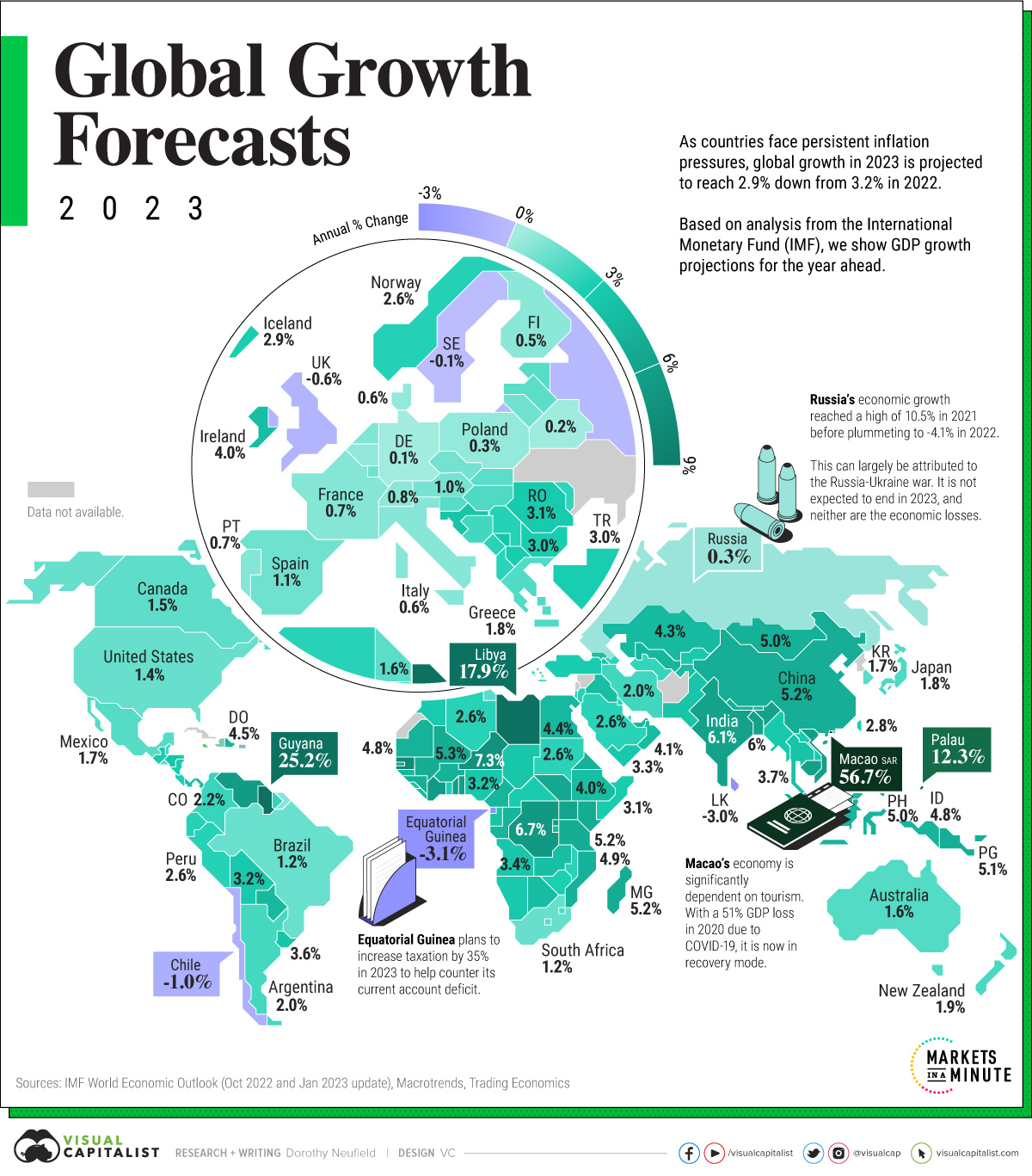
Mapped: GDP Growth Forecasts by Country, in 2023
This was originally posted on Advisor Channel. Sign up to the free mailing list to get beautiful visualizations on financial markets that help advisors and their clients.
Since Russia’s invasion of Ukraine early last year, talk of global recession has dominated the outlook for 2023.
High inflation, spurred by rising energy costs, has tested GDP growth. Tightening monetary policy in the U.S., with interest rates jumping from roughly 0% to over 4% in 2022, has historically preceded a downturn about one to two years later.
For European economies, energy prices are critical. The good news is that prices have fallen recently since March highs, but the continent remains on shaky ground.
The above infographic maps GDP growth forecasts by country for the year ahead, based on projections from the International Monetary Fund (IMF) October 2022 Outlook and January 2023 update.
 Fourth-quarter GDP plummets to levels last seen during pandemic
Fourth-quarter GDP plummets to levels last seen during pandemic
2023 GDP Growth Outlook
The world economy is projected to see just 2.9% GDP growth in 2023, down from 3.2% projected for 2022.
This is a 0.2% increase since the October 2022 Outlook thanks in part to China’s reopening, higher global demand, and slowing inflation projected across certain countries in the year ahead.
With this in mind, we show GDP growth forecasts for 191 jurisdictions given multiple economic headwinds—and a few emerging bright spots in 2023.
*Reflect updated figures from the January 2023 IMF Update.
The U.S. is forecast to see 1.4% GDP growth in 2023, up from 1.0% seen in the last October projection.
Still, signs of economic weakness can be seen in the growing wave of tech layoffs, foreshadowed as a white-collar or ‘Patagonia-vest’ recession. Last year, 88,000 tech jobs were cut and this trend has continued into 2023. Major financial firms have also followed suit. Still, unemployment remains fairly steadfast, at 3.5% as of December 2022. Going forward, concerns remain around inflation and the path of interest rate hikes, though both show signs of slowing.
Across Europe, the average projected GDP growth rate is 0.7% for 2023, a sharp decline from the 2.1% forecast for last year.
Both Germany and Italy are forecast to see slight growth, at 0.1% and 0.6%, respectively. Growth forecasts were revised upwards since the IMF’s October release. However, an ongoing energy crisis exposes the manufacturing sector to vulnerabilities, with potential spillover effects to consumers and businesses, and overall Euro Area growth.
China remains an open question. In 2023, growth is predicted to rise 5.2%, higher than many large economies. While its real estate sector has shown signs of weakness, the recent opening on January 8th, following 1,016 days of zero-Covid policy, could boost demand and economic activity.
A Long Way to Go
The IMF has stated that 2023 will feel like a recession for much of the global economy. But whether it is headed for a recovery or a sharper decline remains unknown.
Today, two factors propping up the global economy are lower-than-expected energy prices and resilient private sector balance sheets. European natural gas prices have sunk to levels seen before the war in Ukraine. During the height of energy shocks, firms showed a notable ability to withstand astronomical energy prices squeezing their finances. They are also sitting on significant cash reserves.
On the other hand, inflation is far from over. To counter this effect, many central banks will have to use measures to rein in prices. This may in turn have a dampening effect on economic growth and financial markets, with unknown consequences.
As economic data continues to be released over the year, there may be a divergence between consumer sentiment and whether things are actually changing in the economy. Where the economy is heading in 2023 will be anyone’s guess.


























